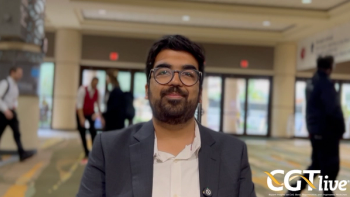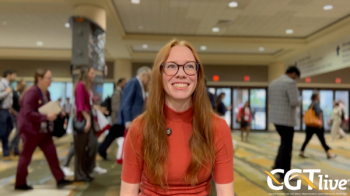
Amrubicin May Be Better Than Topotecan for Second-Line Therapy of Small Cell Lung Cancer
Amrubicin improved response rates, improved progression- free survival (PFS), and achieved enhanced symptom control with acceptable toxicity compared with topotecan.
Amrubicin chemical composition (C25H25NO9).
Amrubicin and topotecan achieved similar overall survival (OS) as second-line treatment of small cell lung cancer (SCLC) in the phase III ACT 1 trial, but amrubicin improved response rates, improved progression- free survival (PFS), and achieved enhanced symptom control with acceptable toxicity compared with topotecan. Further, a modest improvement in OS was observed with amrubicin versus topotecan for refractory patients. These results were reported in June at the ASCO meeting.
This study suggests some benefit for amrubicin in the second-line setting, said lead author Robert Jotte, MD, PhD, director of thoracic oncology for Rocky Mountain Cancer Centers in Denver, Colorado. “Topotecan is too difficult to use and is not a good option for our patients,” he noted.
Five-year survival is about 6% in SCLC and better treatments are needed, he said. Topotecan is approved in the United States and Europe as secondline treatment of SCLC, and amrubicin, a potent topoisomerase II inhibitor, is approved in Japan for SCLC and non—small cell lung cancer. ACT 1 was designed to compare the safety and efficacy of these drugs as second-line treatment for SCLC.
The study randomized 637 patients in a 2:1 ratio to amrubicin 40 mg/m2 intravenous (IV) on days 1 to 3 or topotecan 1.5 mg/m2 IV on days 1 to 5, with growth factors given in the last one-third of the trial. Baseline characteristics were well matched between the 2 groups. The median age was 62 years, about 58% were male, and groups were well matched for sensitive patients and refractory patients (who progressed after first-line therapy) and for extensive and limited disease at diagnosis. One prior line of chemotherapy was allowed for enrollment.
Both arms received a median of 4 cycles of chemotherapy. More patients received full-dose chemotherapy in the amrubicin arm (92.7% vs 86.9%, respectively). More than 75% of the amrubicin patients did not require dose reductions versus 55.3% of the topotecan-treated patients.
OS was not significantly or numerically different between the 2 groups; median OS was 7.5 months in the amrubicin arm versus 7.8 months in the topotecan arm. However, Jotte said that the hazard ratio (HR) of 0.880 suggested that amrubicin achieved some improvement over topotecan after 6 months.
Looking at OS-sensitive versus OS-refractory patients, amrubicin appears to have a modest advantage in OS-refractory patients (median OS of 6.2 mo vs 5.7 mo, respectively), but not in OS-sensitive patients (median OS of 9.2 mo vs 9.9 mo, respectively). Jotte noted that the HR of 0.766 for refractory patients suggested that amrubicin improved survival after 6 months in this subgroup.
Overall response rates significantly favored amrubicin: 31.1% versus 16.9% for topotecan (P = .0001). Time to PFS also favored amrubicin: 4.1 months versus 3.5 months for topotecan (P = .0182).
Amrubicin achieved better control of SCLC symptoms, with improved appetite, cough, and dyspnea, while these symptoms worsened on topotecan. Both treatments caused fatigue, but fatigue was about 3 times greater in the topotecan arm. There were more infections (13.2% vs 8.6% with topotecan) but fewer transfusions needed (31.8% vs 52.8% with topotecan) in the amrubicin arm. More anemia, neutropenia, and thrombocytopenia were reported in the topotecan arm. About 11% of patients in both arms died on treatment. Although there was concern about cardiotoxicity with amrubicin, with cumulative dosing no difference in left ventricular ejection fraction was reported between the 2 arms.
During the question-and-answer session following the talk. Steven Vogl, MD, a community oncologist in New York City, said that there are other second-line options for this poor-risk population. “Some of them will be sensitive to etoposide and cisplatin,” he noted. “The use of amrubicin, at least in my practice, will depend on the costs.”
Jotte R, Von Pawel J, Spigel DR, et al. Randomized phase III trial of amrubicin versus topotecan as second-line treatment for small cell lung cancer. J Clin Oncol. 2011;29 (suppl; abstr 7000).
Newsletter
Stay at the forefront of cutting-edge science with CGT—your direct line to expert insights, breakthrough data, and real-time coverage of the latest advancements in cell and gene therapy.

















































